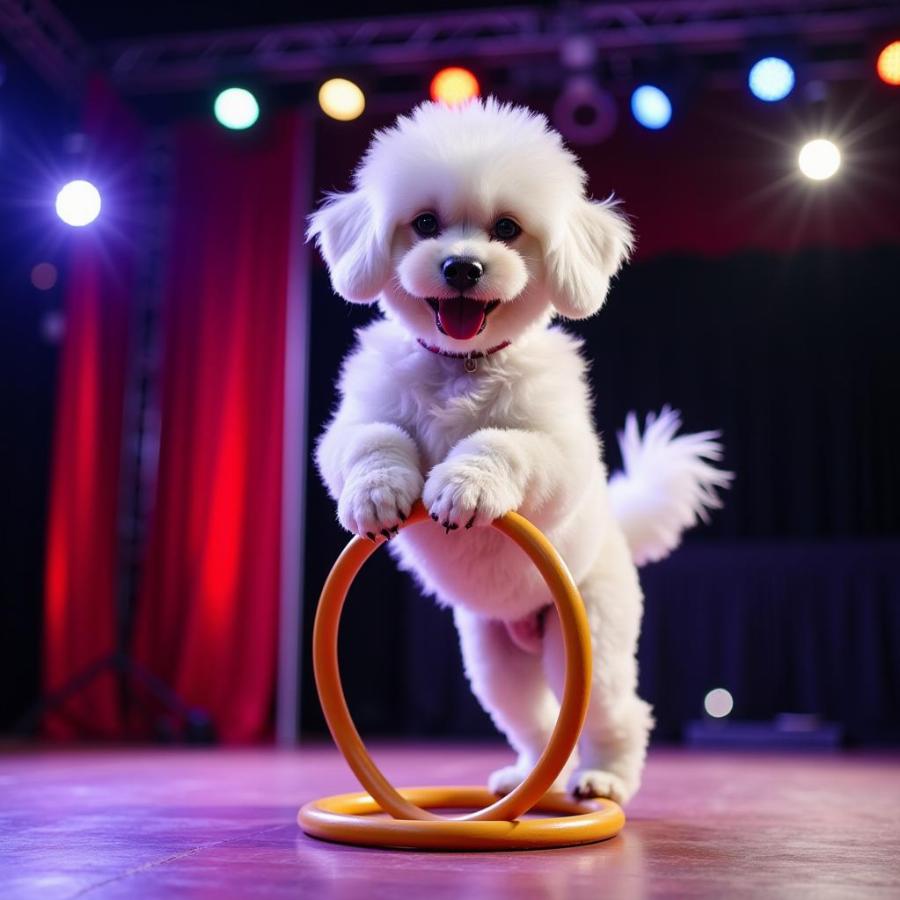White dancing dogs, a captivating sight, bring joy and wonder to audiences worldwide. Whether it’s a small white fluffy dog learning tricks or a larger breed performing choreographed routines, these talented canines capture our hearts with their grace and intelligence. This article delves into the fascinating world of white dancing dogs, exploring various breeds known for their aptitude, training techniques, and the sheer delight they bring to our lives.
Breeds Known for Their “White Dancing Dog” Prowess
Many breeds excel in canine performance arts, and several of these breeds boast stunning white coats. Some popular choices include the Bichon Frise, known for its playful personality and fluffy white fur, making it a natural for tricks and performances. The West Highland White Terrier, with its compact size and energetic nature, also thrives in agility and obedience training, often showcasing impressive dancing skills. Other breeds, like the Samoyed with its elegant white coat, or the American Eskimo Dog, also contribute to the world of “white dancing dogs” with their intelligence and trainability.  Bichon Frise Performing Tricks
Bichon Frise Performing Tricks
Training Your White Dancing Dog: Tips and Techniques
Training a “white dancing dog” requires patience, consistency, and positive reinforcement. Start with basic obedience commands like sit, stay, and come. Gradually introduce tricks, using treats and praise as rewards. Keep training sessions short and engaging to maintain your dog’s interest. Clicker training can be particularly effective, as the distinct sound marks the desired behavior precisely. Remember, each dog learns at its own pace, so avoid pushing your furry friend too hard.
The Joy of Performance: Why We Love White Dancing Dogs
White dancing dogs offer more than just entertainment. Their performances strengthen the bond between dog and owner, showcasing the remarkable connection they share. The dedication and teamwork involved in training create a unique partnership built on trust and mutual understanding. Watching these talented canines perform brings joy and inspiration, reminding us of the incredible abilities of our furry companions. dancing white dog
Choosing the Right White Dog Breed for Performance
Selecting the right breed for canine performance depends on several factors, including your lifestyle, experience with dog training, and the specific type of performance you envision. While many white-coated breeds excel in various disciplines, it’s essential to research each breed thoroughly. Consider their energy levels, trainability, and grooming needs. For example, a high-energy breed like the American Eskimo Dog might be a good fit for agility, while a smaller breed like the Maltese could be better suited for trick training. good dog names for white dogs
Caring for Your Performing Pup
A performing dog requires special care to ensure they stay healthy and happy. Regular veterinary checkups are essential, along with a balanced diet and appropriate exercise. Grooming plays a crucial role, especially for white-coated dogs. Regular brushing helps maintain their beautiful fur and prevents matting. Consider using dog coats, particularly for smaller breeds, to protect them from the elements during outdoor performances or training sessions. dog coats small dogs
Conclusion: The Magic of White Dancing Dogs
White dancing dogs enchant us with their grace, intelligence, and the pure joy they exude. From the fluffy Bichon Frise to the elegant Samoyed, these talented canines bring a unique charm to the world of performance. Whether you’re training your own “white dancing dog” or simply admiring their captivating performances, these furry artists remind us of the special bond we share with our canine companions. white fluffy dog names
FAQ
-
What are some good breeds for dog dancing? Breeds like the Poodle, Border Collie, and Australian Shepherd are known for their intelligence and trainability, making them excellent choices for dog dancing.
-
How do I start training my dog to dance? Begin with basic obedience commands and gradually introduce tricks, using positive reinforcement and clicker training.
-
How long does it take to train a dog to dance? The training timeline varies depending on the breed, individual dog, and complexity of the routine.
-
What are the benefits of dog dancing? Dog dancing strengthens the bond between dog and owner, provides mental and physical stimulation for the dog, and offers a fun and rewarding activity for both.
-
Where can I find dog dancing classes? Search online for local dog training facilities or clubs that offer dog dancing classes.
-
What equipment do I need for dog dancing? Essential equipment includes a comfortable harness or collar, a leash, treats, and a clicker.
-
Is dog dancing suitable for all breeds? While most breeds can participate in dog dancing, some breeds are naturally more predisposed to excel in this activity.
More Questions You Might Have About White Dogs
- What are some popular names for white fluffy dogs?
- What are the best grooming tips for keeping a white dog’s coat clean?
- Are there any health concerns specific to white dog breeds?
Beaut Dogs is your go-to resource for all things related to canine companions, providing expert advice and valuable insights into the world of dogs. Beaut Dogs offers a wealth of information on various breeds, care tips, and training techniques. When you need assistance, contact us via Email: [email protected] for detailed and accurate answers from Beaut Dogs.